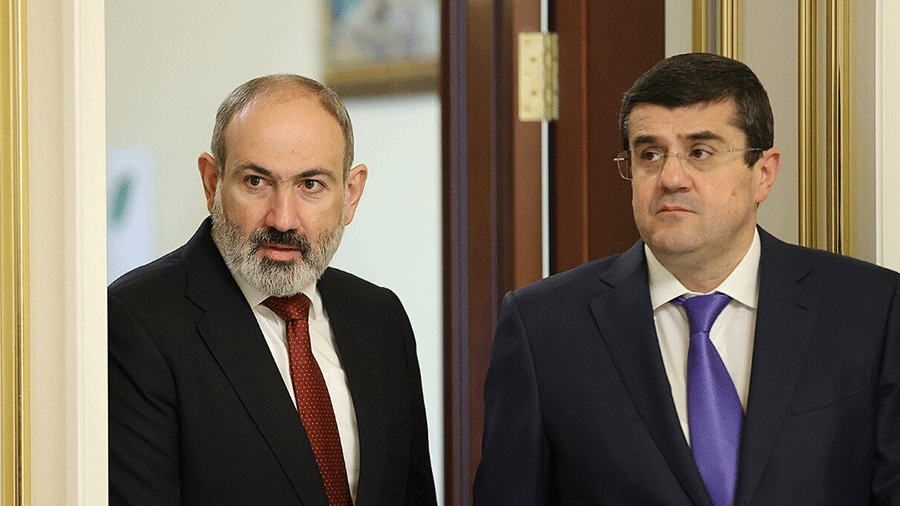On August 25, a press conference dedicated to the situation in Artsakh was held.
HRACHYA ARZUMANYAN, doctor of political sciences, was present at the press conference. After the press conference, the following press release was distributed
ARPI TOPCHYAN, representative of «Berd» NGO, public figure
NINA KARAPETYANTS, head of the Helsinki Association, human rights activist
Read also
MARGARITA KARAMIAN, head of «Return to Dizak» NGO
LEVON HAYRIYAN, head of the NGO «For the sake of Hadrut»
In 2020, the victory of the Russian-Turkish strategic alliance in the second Artsakh campaign, supported by a broad alliance of state and non-state actors, including jihadists, led to the collapse of the security architecture of the South Caucasus. The ceasefire agreement sealed as a result of the large-scale military operations, assuming Russia as the guarantor of security, did not put an end to the military conflict.
The military operations have acquired the nature of hybrid warfare, waged by Russia and Turkey, with the involvement of Azerbaijan, in order to carry out a proxy war against the Republic of Armenia and Artsakh. Moreover, irregular military operations are being widely practiced in the form of short-term skirmishes, sabotage, and shooting of civilians, which leads to casualties among military personnel and civilians. The blockade of Artsakh lasting for more than 200 days, despite the demands of the international community, is also an example of military operations. The enemies widely use the methods of economic, informational and psychological warfare against the Armenian people and their statehood. As a result of the ongoing aggression, the Republic of Armenia and Artsakh continue to lose territories. The aim of the hybrid war is to force Armenia to make concessions in the geopolitical arena, ultimately leading to the abolition of the state sovereignty of the Armenian people.
The policy of the authorities of Yerevan and Stepanakert contributes to the aggression: The current elite of the Republic of Armenia refuses the role of the guarantor of the security of Artsakh, striving to turn the Artsakh problem into a purely humanitarian one, which can be solved on the basis of the principle of territorial integrity of Azerbaijan. At the same time, the authorities of Yerevan ignore the declaration of independence of Armenia, the principle of the right of nations to self-determination, on the basis of which the Artsakh Armenians built the Republic of Artsakh, a de facto existing state, whose international status should be determined within the framework of the OSCE Minsk Group.
The authorities of the Republic of Armenia follow a political line aimed at keeping Armenia in the orbit of the unreserved influence of Russia and Turkey and excluding the formation of an independent policy and strategy for preserving the state sovereignty of the Armenian people.
As a result of the second Artsakh war of 2020 and the appearance of the military presence of Russia and Turkey in Artsakh, the authorities of Stepanakert mutated into a collaborative regime conducting anti-Armenian policy, which represents exclusively the interests of Russia and Turkey. After 2020, the disastrous policy of the Yerevan and Stepanakert authorities led to the return of the military threats of the physical destruction of the Artsakh population and the implementation of the Armenian Genocide, which was overcome during the 1991-94’s first Artsakh war. The enemies of the Armenian people consider the loss of Artsakh’s statehood as the most important stage in the implementation of this policy.
It is beyond any doubt that the fate of the Artsakh people should be viewed through the prism of the Armenian question, putting all necessary efforts to convey to international organizations and power centers the Russia-Turkey alliance’s intention to continue the Genocide in Artsakh. The politics conducted by Yerevan and Stepanakert makes it difficult for the international community to provide assistance to Artsakh people due to the lack of a state actor ready to represent Artsakh’s national interests in the international political arena.
The most important problem and challenge for the Artsakh population is the preservation of the de facto existing state of the Republic of Artsakh, within which they fought for their right to self-determination. Artsakh Armenians must defend their right to return to the negotiating table to protect national interests and basic rights and freedoms, including the right to life, self-defense, and building a democratic society.At the same time, the processes of self-organization of the Artsakh society play a big role. The emergence of new social figures capable of resisting the intentions of the enemies of the Armenian people and their supporters in Stepanakert and Yerevan to eliminate the state sovereignty of the Armenian people in Artsakh becomes crucial for survival in Artsakh. The support of such public powers becomes imperative for the Armenian people as a global phenomenon.
It is extremely important to restore trust between the Republic of Armenia and Artsakh, when the policies and strategies of the two Armenian states are synchronized and united again in the settlement of the Artakh issue.
The roadmap for the protection of Artsakh Republic and the Artsakh people includes a number of stages, the implementation of which should take place in parallel.
These stages include: a change of government in Stepanakert, replacement of the Russian military contingent with international peacekeeping forces, development of international mechanisms that will guarantee the right of Artsakh people to move and communicate with the outside world, creation of conditions to return Artsakh to the international community and its political, cultural, and humanitarian arenas.
The solution of these problems is possible only by involving the potential and abilities of the entire Armenian population.





















































